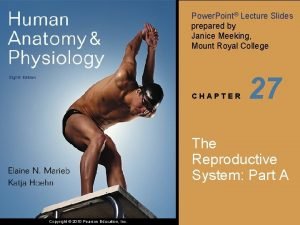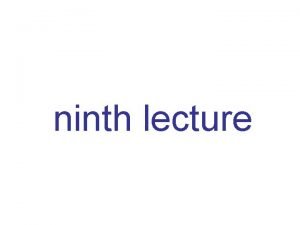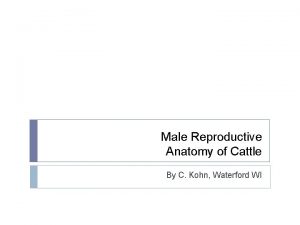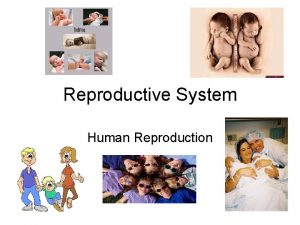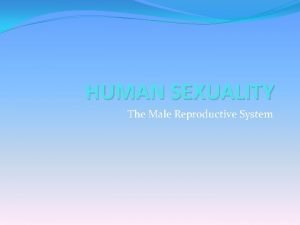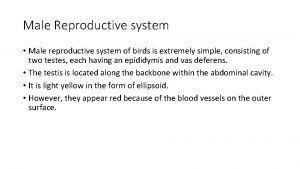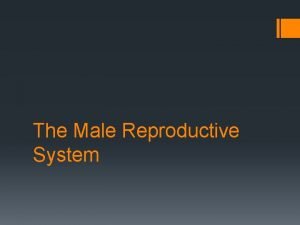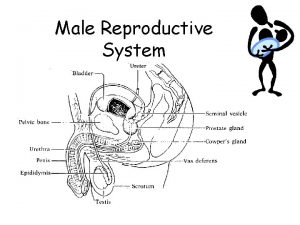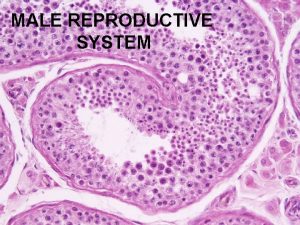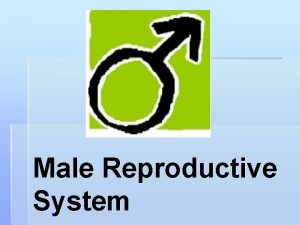Human Reproduction 6 6 Male Reproductive System The
















- Slides: 16

Human Reproduction 6. 6

Male Reproductive System

• The role of testosterone – During week 7 of embryonic development, testosterone intiates the formation of male genitalia – During the midteens testosterone intiates the development of male secondary sex characteristics • Increase in muscle mass • Increase in the length of the vocal chords (voice deepens) • Increase in the length of the bones (height) • Spermatogenesis (creation of sperm) • Facial hair

Female Reproductive System

The menstrual cycle ·The menstrual cycle is regulated by hormones of the hypothalamus, anterior pituitary, and ovaries http: //health. howstuffworks. com/sexu al-health/female-reproductivesystem/menstruation. htm


Menstruation Phase (The egg or ovum from the previous cycle was not fertilized) ·The endometrium is shed - the inner lining of the uterus that becomes highly vascular (rich with blood vessels) so that a fertilized egg can implant. - break down of blood vessels leads to the menstrual bleeding of a typical cycle.

Menstruation Phase ·Hypothalamus releases Gonadotropin Releasing Hormone (Gn. RH). - target tissue of Gn. RH is the anterior pituitary ·Gn. RH stimulates the anterior pituitary to release Follicle Stimulating Hormone (FSH) and Lutenizing Hormone (LH) - target tissue of FSH and LH are the ovaries.

Preovulatory (Proliferative) Phase ·FSH stimulates the development of a few follicles in the ovary - Follicles are immature egg cells in the ovaries that are in the process of going through meiosis in order to become oocytes (mature eggs) ·In response to FSH and LH the ovaries produce the hormone estrogen. - the target tissue of estrogen is the endometrium of the uterus. - results in endometrium becoming highly vascular. ·Spike in FSH and LH leads to ovulation (release of oocyte from a follicle)


Postovulatory (Secretory) Phase ·the outer ring of cells from the ruptured follicle remain in the ovary and become the corpus luteum - a glandular structure that fills in the 'wound' left by ovulation - produces progesterone for 10 -12 days after ovulation ·Progesterone targets the uterus to maintain the thickened endometrium - also provides negative feedback to the hypothalamus to prevent production of Gn. RH http: //highered. mcgrawhill. com/sites/0072495855/student_view 0/chapter 28/animation__maturatio n_of_the_follicle_and_oocyte. html

Postovulatory (Secretory) Phase ·If fertilization does not occur, the corpus luteum degenerates and ceases production of hormones, causing menstruation ·If fertilization does occur, implantation occurs in the uterus on about the third day after fertilization


Overview • The menstrual cycle – The menstrual cycle is regulated by hormones of the hypothalamus, anterior pituitary, and ovaries – During the menstrual phase, in which the endometrium is shed, Gonadotropin Releasing Hormone (Gn. RH) is released from hypothalamus, which stimulates the anterior pituitary to release Follicle Stimulating Hormone (FSH) and Lutenizing Hormone (LH) – FSH stimulates the development of a few follicles in the ovary

Overview • Follicles are cells that are in the process of going through meiosis in order to become oocytes (mature eggs) – During the preovulatory phase, the developing follicles secrete estrogens – The follicle completes maturation due to stimulation by LH and FSH – The postovulatory phase occurs after ovulation, and LH stimulates development of the corpus luteum

Overview • The corpus luteum produces progesterone, and some estrogens – If fertilization does not occur, the corpus luteum degenerates and ceases production of hormones, causing menstruation – If fertilization does occur, implanation occurs in the uterus on about the third day after fertilization – Membranes produce h. CG (human chorionic gonadotropin) which signal pregnancy
 Function of vagina
Function of vagina Function of male
Function of male Frog testis labeled
Frog testis labeled Exercise 42 anatomy of the reproductive system
Exercise 42 anatomy of the reproductive system Oogenesis
Oogenesis Dot quizlet
Dot quizlet Parts of male and female reproductive system
Parts of male and female reproductive system Produces a lubricating mucus that cleanses the urethra
Produces a lubricating mucus that cleanses the urethra Luteinizing hormone in male reproductive system
Luteinizing hormone in male reproductive system Male reproductive system in plant
Male reproductive system in plant Art-labeling activity: the male reproductive system, part 1
Art-labeling activity: the male reproductive system, part 1 Male reproductive system information
Male reproductive system information Where is sperm located
Where is sperm located Bull reproductive system parts and functions
Bull reproductive system parts and functions Male genital anatomy front view
Male genital anatomy front view Examples of asexual reproduction
Examples of asexual reproduction Function of male reproductive system
Function of male reproductive system










